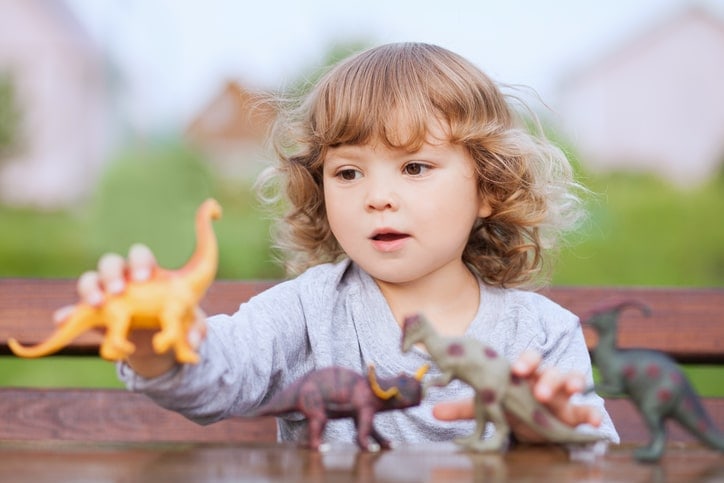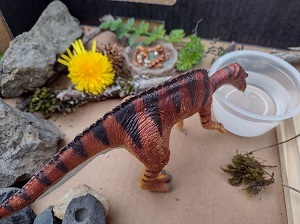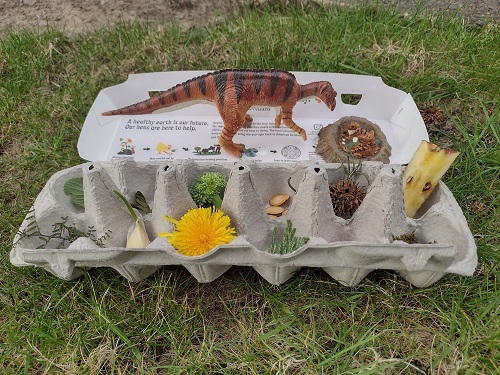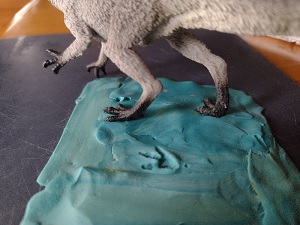These preschool dinosaur activities begin with a thought experiment. If you were given a living dinosaur to take care of, what would you do? There are no rules, and kids can use a variety of props to bring their ideas to life. The goal is to learn about dinosaurs, think imaginatively, solve practical problems, and keep a record of your discoveries.

Preparation
To begin, you’ll need at least one toy dinosaur, preferably one that is fairly accurate in its representation. Then you’ll want to help help your child learn more about the creature. What did it eat? How did it move? Do scientists think it lived alone or in groups? A good online resource for parents and teachers is the Dino Directory of the Natural History Museum of London.
In addition, you’ll need to gather objects for building a creature habitat. Objects like:
- toy blocks
- cardboard boxes, tubes, canisters, or egg cartons
- bowls
- sand, clay, rocks, moss, leaves, conifer needles
Inspire pretend play with dinosaur “zookeeping”
You can get kids started by asking a simple question. “What if you had a real (insert creature name here) to take care of?” What would you do?

For younger kids, tackling this problem may consist of making a crude creature habitat, and, possibly, considering the animal’s needs for food and water.
Older kids might confront more complicated challenges, like figuring out how to subdue a dangerous, injured dinosaur so it can get medical treatment.
Leave kids free to develop their own scenarios, but be ready to participate. You can stimulate play by asking questions.
- What should you feed your creature?
- Where will it sleep?
- What materials can the creature use to build a nest?
- Where can the creature lay eggs or keep its babies safe and warm?
- What can the creature do for exercise?
- How can you keep the creature from getting bored?
Expand play to include other preschool dinosaur activities, including the following.
Feeding herbivores: Preschool dinosaur activities about diet
Food search and “taste test”
There were many herbivorous dinosaurs, and some of these can be found as plastic toys, including sauropods, “duckbills” (hadrosaurs), Stegosaurus, Triceratops, and others. Talk with your child about what kinds of plant foods your creature may have eaten. Then launch a mission: Let’s look for foods to offer the dinosaur.

Your child can try searching outdoors in a green space – a park, garden, or backyard. You might also try raiding your own kitchen. Encourage your child to collect small samples of possible food items, including broad leaves, grass blades, berries, conifer needles, and flower petals. A handy way to sort and store your child’s collection is to use a recycled egg cartoon.
Some foods might not have existed during the time when your creature was alive, so you can discuss this if you’d like. Maybe your creature will be willing to try something new!
To expand this activity, you can ask your child to stage a pretend “taste test” – presenting each food type to the dinosaur, and then deciding if the dinosaur “likes” it. Your child can take notes on the results of the taste test, either by drawing pictures or having you help with a written record of the outcome.
An experiment with “gizzard stones”

Paleontologists believe that some toothless, plant-eating dinosaurs swallowed gastroliths or “gizzard stones” — stones that remained in a muscular part of the stomach, where they helped grind up tough, fibrous foods (University of California Museum of Paleontology 2007).
You can have your child test the effectiveness of gizzard stones by placing several stones in a paper or plastic bag with some leaves. (You can use salad greens if you prefer). Help your child wad up and twist the bag, feeling for the stones within, and grinding them with the leaves. Then open the bag and see what has happened. Are the leaves mashed up now?
Making tracks: Preschool dinosaur activities using plastic toys

Make dino-tracks by dipping the toy’s feet in finger paint and stamping foot prints onto paper. Alternatively, roll out some clay and have kids make impressions. Then encourage kids to examine the toys’ feet, and ask these questions:
- What do the feet look like?
- What shape are they?
- Do the dinosaur’s feet remind you of the feet of any other animals? Which ones?
Kids can keep track of their observations in a zoo keeper’s log (below).
If you have several different toys, you can also work backwards — beginning with the footprints. Make footprints for each toy, then ask kids to examine the prints and the toys. Can they guess (predict) which toys made each set of prints? Have kids check their predictions by making their own prints. For related ideas, see my Parenting Science article, Preschool and kindergarten science activities about tracking animals.
Recording observations
Keep a record of your preschool dinosaur activities with a zookeeper’s log or scrapbook. Your child can draw pictures, and dictate written notes for you to include. You can also include images of your creature’s footprints, photographs of its habitat, and physical specimens representing your creature’s preferred food or nesting material. Flat specimens, like leaves, can be pasted directly onto paper. Other materials can be stored in plastic bags and stapled in place.
Making comparisons
Compare the size of your creature with the size of other, living animals. If your toy were life-size, how big would it be? Help kids understand size differences by comparing their creature to animals and objects they are familiar with. Would the creature be the size of a chicken? An adult human? A school bus?
Preschool activities: More ideas
Looking for more? These teaching tips may inspire you to create more preschool dinosaur activities on your own. And check out my preschool science activities page. There you will find the instructions for several experiments and projects, as well as science-based tips for presenting science to young children.
References
This scientific paper discusses the evidence for gastroliths in several types of dinosaur:
Wings O and Sander PM. 2007. No gastric mill in sauropod dinosaurs: new evidence from analysis of gastrolith mass and function in ostriches. Proc Biol Sci. 274(1610):635-40.
For a less technical account of gastroliths in dinosaurs, see this article on the University of California Museum of Paleontology website.
Content last modified 3/2022
image of child with toy by Alina Demidenko / iStock